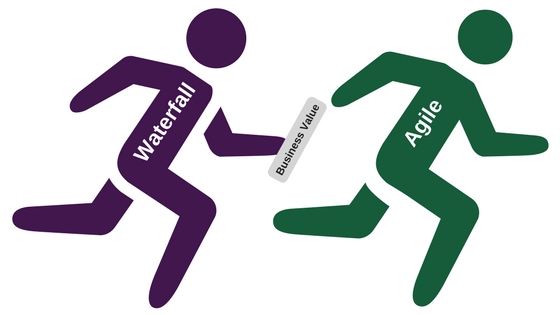Humans have been developing processes and refining how to manage work for many years. The Brief History of Project Management dates the application of Project Management (PM) back to the construction days of the Great Pyramids of Giza. Today, we can safely say that traditional, or Waterfall, project management has developed deeper, stronger roots and created solid ties to the way we work, and design our organizational structure and culture.
Agility has also more recently emerged as a mindset, a set of values and principles to gear our efforts toward efficiency and value delivery. Agile is not a process or methodology by itself. Rather, Agile approaches such as Scrum, Kanban, Lean, etc., give us a framework and structure to continuously deliver. Although Agile is relatively new, its rolling success in delivering more within the challenges of the triple constraints (scope, time and budget) has gained it popularity and wider adoption in the project management world.
So, does this mean “being agile” is at odds with structured project management? Is one always better than the other? Does one need to fail for the other one to succeed? Our experience reveals otherwise. For instance, when working with a Project Management Office (PMO) client charged with leading an Agile Transformation, we found that by using a “collaborative approach” model early in the transformation process, we were able to successfully align the transition efforts with the gradual nature of Agile adoption. Using this collaboration of approaches, business units were enabled to continue leveraging their strengths in structured project management principles for high-level design and scope definition activities while the development teams were coached in executing iterations or sprints using Agile methodologies. As a result, our PMO client was able to effectively facilitate the transformation and change management processes for three Agile pilot teams leveraging both approaches for effective delivery.
Concurrently, below are some concepts to consider when comparing Agile and traditional project management approaches:
- They share a similar cause. Both Agile and Waterfall were invented as part of our process management efforts to work and deliver more efficiently. If there has to be a contest, consider a medley or relay team. Both approaches work as teammates, with different skillsets and experience, working towards the same goal, each trying to evolve and maximize their value to the whole effort. The earlier member passes the baton to the next to get to the finish line in order to win the ultimate prize of value delivery and continuous improvement. The earlier approach consequently continues to evolve and move forward, adapting to the best means that enables better results.

- Neither has been proven to be a “be-all” or “end-all” solution for a given product, project or portfolio. It’s like comparing a plane and a car, sometimes you have to drive to the airport to get to the plane. By the same token, one approach can potentially leverage or complement the other. For instance, in the case where a project or product has an element of complexity where requirements cannot be fully defined in advance, the plan-driven or Waterfall way of detailed upfront planning is not likely feasible. Rather, adopting an incremental and iterative planning approach while leveraging traditional, upfront roadmapping for design and communicating high-level project or product goals and deliverables can guide releases and delivery.
- One is not inherently “better” than the other. Each approach has a time and a place for enabling business success. Many approaches fail because they tend to focus heavily on pushing a selected framework with prescribed approaches that may not take into account the unique aspects of a project or product. Considering available process options in light of such unique factors and organizational culture will play a significant role in determining the best approach.
The bottom line is that our fast-paced world continues to present us with complex challenges to be creative in finding the right tools, techniques and adapting the required mindset that can help us work more efficiently and deliver faster results. To this end, it’s not about competing between these two approaches, but rather finding the best approach that works.
Are you trying to decide whether to continue with traditional project management or make the move towards becoming Agile? Are you unsure about which approach will best meet the needs of your organization? In our next “Agile vs. Waterfall Project Management Series: What’s the Right Approach?,” we will discuss the lessons learned from our experience facilitating large enterprise adoptions and explore proven tools and techniques to consider when selecting the best approach for your next project or product delivery.
In the meantime, below is a simple two-step tip you can use right away to help inform your decision:
- Understand your current state – examine the information you already have based on the nature of the project or product in question. Is this a novel product or project? What’s the complexity level? Are requirements bound to change a lot? etc.
- Analyze your results against the benefits of each approach, define what’s most relevant to you, your desired outcomes, and how to measure success against those outcomes.
Contact us to learn more.
